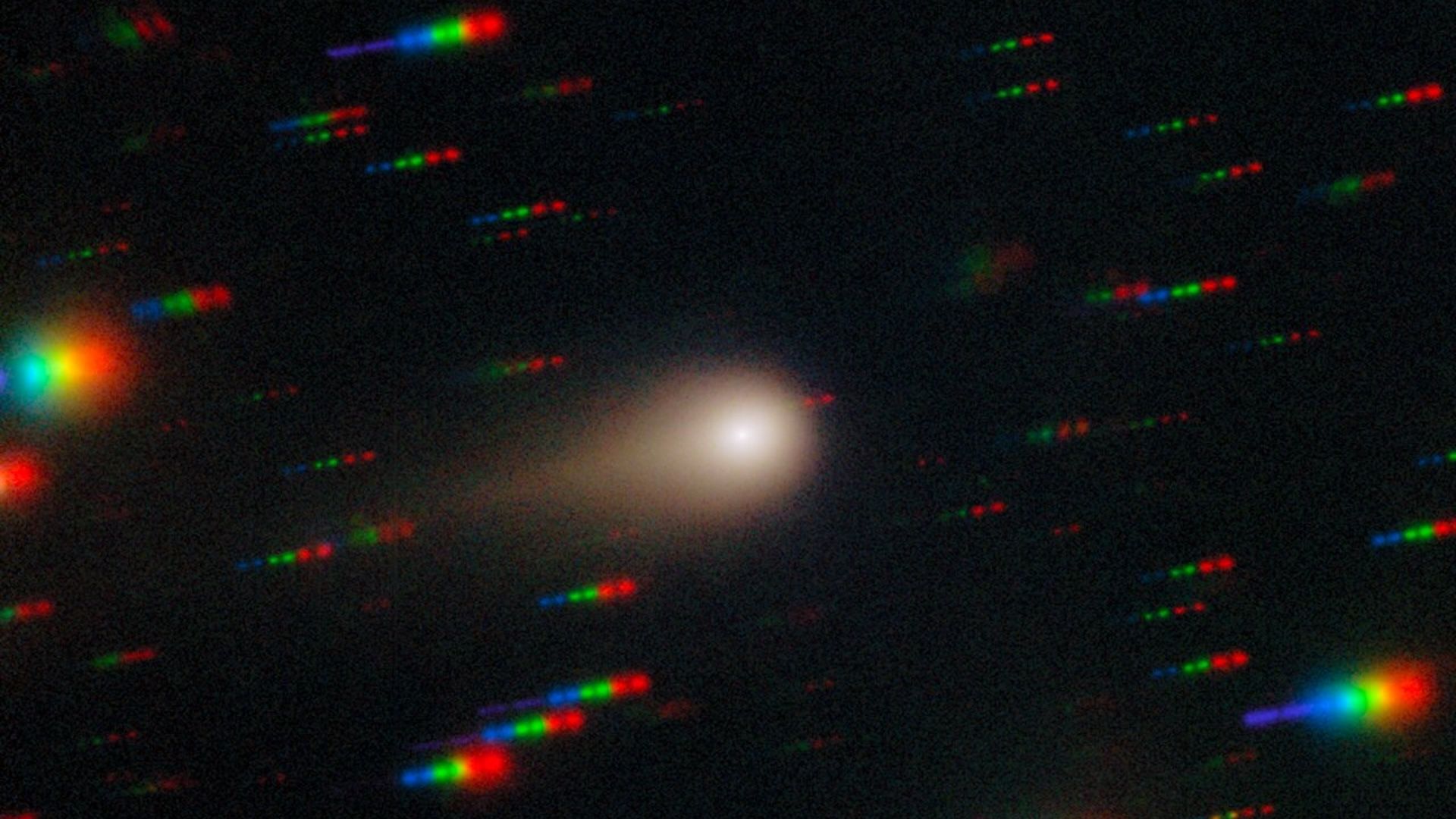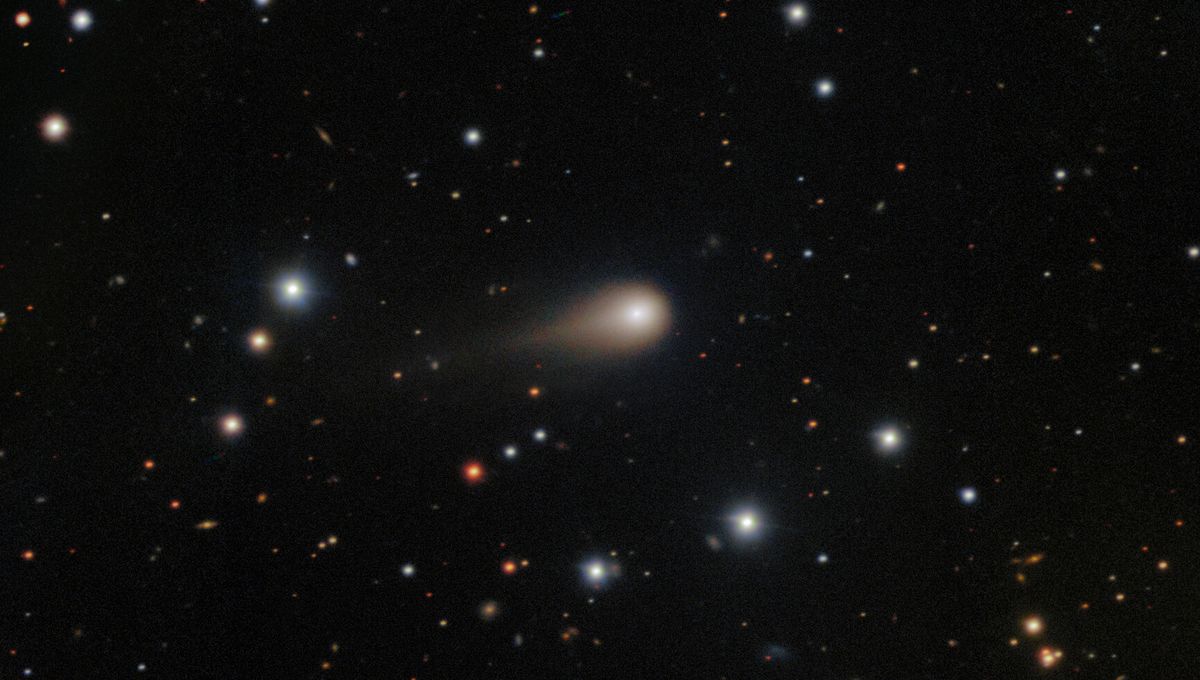About a month from now, the interstellar object 3I/ATLAS will be on the far side of the Sun, making it unobservable from Earth. On October 3, 2025, it will pass within 29 million kilometers from Mars and the HiRISE camera onboard the Mars Reconnaissance Orbiter will be able to image it with a pixel resolution of 30 kilometers.
The time is ripe to summarize what we know so far about 3I/ATLAS.
First, 3I/ATLAS does not feature a distinct cometary tail based on the highest resolution image taken by Hubble Space Telescope on July 21, 2025 (reported here). The image shows a fuzzy glow of scattered sunlight that does not extend to the far tail side of the object — away from the Sun, any more than it extends on the side perpendicular to that direction. In fact, the only elongation of the glow is towards the Sun in the anti-tail direction. If the scattering of sunlight had been off dust particles, then these particles would have been pushed by solar radiation pressure from the Sun-facing direction to the opposite side and would have displayed a generic cometary tail stretched over a few arcseconds behind the object, easily detectable by the Hubble Space Telescope. The fact that this tail is not observed suggests that 3I/ATLAS does not shed much dust particles with a size comparable to the wavelength of sunlight, of order 0.5 micrometer.
The spectrum of 3I/ATLAS shows substantial reddening. In the absence of sub-micrometer dust, the reddening must originate from the solid surface of 3I/ATLAS. This is not unexpected since similar reddening is observed from the surfaces of Kuiper belt objects, like Arrokoth, which are similarly exposed to interstellar cosmic-rays.
To produce this reddening without shedding sub-micron dust particles, most of the sunlight reflected from 3I/ATLAS must originate at its surface. It then follows that the brightness of 3I/ATLAS implies a surface diameter of 20 kilometers for an albedo of 5% that characterizes Kuiper belt objects.
The flux detected by the SPHEREx space observatory at a wavelength of 1 micrometer from 3I/ATLAS on August 8–12, 2025 suggests an even larger nucleus with a diameter of 46 kilometers (as reported here). This implies that the mass of 3I/ATLAS is a million times larger than that of the previous interstellar comet 2I/Borisov. This huge gap in mass is surprising since we should have discovered numerous objects of the size of 2I/Borisov before discovering a 46-kilometer interstellar object. Moreover, as I noted in my first paper on 3I/ATLAS (accessible here), the amount of rocky material per unit volume in interstellar space is smaller by a factor of ten thousand than the value needed to deliver into the inner Solar system one giant rock of this size over the decade-long survey conducted by the ATLAS telescope.
The SPHEREx images show 3I/ATLAS as a point source with no dust coma or tail. The observations reveal a cloud of carbon dioxide (CO2) around 3I/ATLAS out to distances of at least 348,000 kilometers, corresponding to a mass loss rate of about 70 kilograms per second. No water (H2O) cloud was detected by SPHEREx, setting an upper limit of 4.5 kilograms per second on the water mass loss rate. This is an order of magnitude below the previous claims of water detection which reported a mass loss rate of order 40 kilograms per second. Apparently, these early claims are not real as I argued in a previous essay (accessible here). The SPHEREx report notes that “The lack of a bright water gas coma is puzzling as 3I/ATLAS was not too far outside the Solar system’s “water ice line” at 2.5 AU during the observations.”
The glow around 3I/ATLAS in the Hubble Space Telescope image could originate from the reflection of sunlight by fragments of CO2 ice that 3I/ATLAS sheds rather than dust. These icy fragments evaporate in the sunlight and create the spherically symmetric CO2 cloud around 3I/ATLAS, as observed by SPHEREx.
The modest level of CO2 mass loss amounts to the ablation of a millimeter thick layer from the surface of a 46-kilometer object over a period of 10 years. In other words, a relatively thin outer layer is sufficient to maintain the observed cloud of CO2 gas around 3I/ATLAS. What lies under this outer skin remains unknown.
A way to resolve the discrepancy between the mass reservoir of rocky material in interstellar space and the unexpected discovery of a large object that measures tens of kilometers in diameter, is that 3I/ATLAS was not drawn from a population of rocks on a random trajectory but instead — its trajectory was designed to target the inner Solar system. This possibility is consistent with the alignment of this trajectory with the orbital plane of the planets around the Sun, a coincidence of a part in 500 for a random occurrence (as discussed here).
Given the puzzling characteristics of 3I/ATLAS, we should use all telescopes at our disposal on Earth and in space to observe it (as discussed here). As the Sun turns on the heat on 3I/ATLAS in the coming months, it could reveal its true nature.
Ecclesiastes was not aware of interstellar objects when he argued that “there is nothing new under the sun.”
Life is a learning experience and we should not exclude surprises. Paraphrasing Forrest Gump, “science is like a box of chocolates, you never know what you’re gonna get.”
ABOUT THE AUTHOR
Avi Loeb is the head of the Galileo Project, founding director of Harvard University’s — Black Hole Initiative, director of the Institute for Theory and Computation at the Harvard-Smithsonian Center for Astrophysics, and the former chair of the astronomy department at Harvard University (2011–2020). He is a former member of the President’s Council of Advisors on Science and Technology and a former chair of the Board on Physics and Astronomy of the National Academies. He is the bestselling author of “Extraterrestrial: The First Sign of Intelligent Life Beyond Earth” and a co-author of the textbook “Life in the Cosmos”, both published in 2021. The paperback edition of his new book, titled “Interstellar”, was published in August 2024.
Source link


